外文资料翻译
外文文献怎么翻译
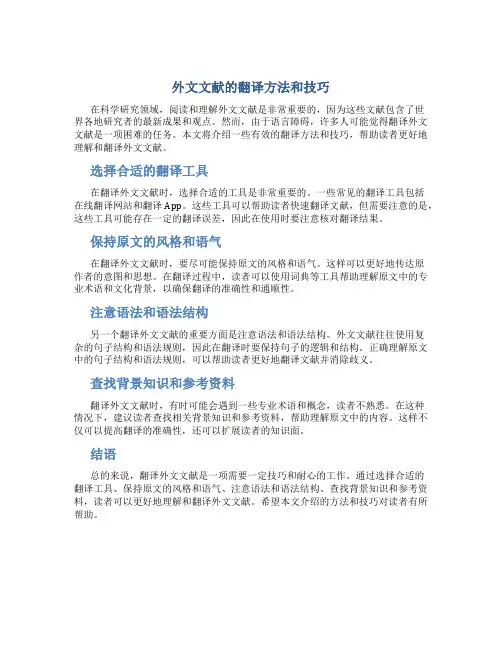
外文文献的翻译方法和技巧在科学研究领域,阅读和理解外文文献是非常重要的,因为这些文献包含了世界各地研究者的最新成果和观点。
然而,由于语言障碍,许多人可能觉得翻译外文文献是一项困难的任务。
本文将介绍一些有效的翻译方法和技巧,帮助读者更好地理解和翻译外文文献。
选择合适的翻译工具在翻译外文文献时,选择合适的工具是非常重要的。
一些常见的翻译工具包括在线翻译网站和翻译App。
这些工具可以帮助读者快速翻译文献,但需要注意的是,这些工具可能存在一定的翻译误差,因此在使用时要注意核对翻译结果。
保持原文的风格和语气在翻译外文文献时,要尽可能保持原文的风格和语气。
这样可以更好地传达原作者的意图和思想。
在翻译过程中,读者可以使用词典等工具帮助理解原文中的专业术语和文化背景,以确保翻译的准确性和通顺性。
注意语法和语法结构另一个翻译外文文献的重要方面是注意语法和语法结构。
外文文献往往使用复杂的句子结构和语法规则,因此在翻译时要保持句子的逻辑和结构。
正确理解原文中的句子结构和语法规则,可以帮助读者更好地翻译文献并消除歧义。
查找背景知识和参考资料翻译外文文献时,有时可能会遇到一些专业术语和概念,读者不熟悉。
在这种情况下,建议读者查找相关背景知识和参考资料,帮助理解原文中的内容。
这样不仅可以提高翻译的准确性,还可以扩展读者的知识面。
结语总的来说,翻译外文文献是一项需要一定技巧和耐心的工作。
通过选择合适的翻译工具、保持原文的风格和语气、注意语法和语法结构、查找背景知识和参考资料,读者可以更好地理解和翻译外文文献。
希望本文介绍的方法和技巧对读者有所帮助。
毕业论文设计外文资料翻译
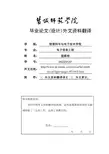
毕业论文(设计)外文资料翻译学院:物理科学与电子技术学院专业:电子信息工程姓名:雷顺明学号:05223137外文出处:/colourful-rhyth ms-of-light-tango-r971913.htm附件:1、外文资料翻译译文;2、外文原文。
指导教师评语:该同学的外文资料翻译较准确,说明前期准备阶段的文献调研做了一定的工作,达到了预期目的。
签名:年月日附件1:外文资料翻译译文简易音乐彩灯控制器本例介绍一个简易音乐彩灯控制器,它的电路结构虽然非常简单,但使用效果很好,适宜初学者制作。
工作原理:简易音乐彩灯控制器电路如图所示,电路主要采用了一只晶闸管和一只三极管等组成。
220V交流电经灯串EL和二极管VD1一VD4桥式整流后变成约200V的脉动电压,一路加在晶闸管VT的两端作为VS工作所需的正向阳极电压;另一路经R1与R4分压,并经电容Cl滤波,在Cl两端可获得约3V左右稳定的直流电压,作为三极管VT的工作电压。
RP为声控灵敏度调节电位器,要求环境在无音乐声场时,调整RP使三极管VT刚好处于临界导通状态,这时VS的门极被VT短接无法获得触发电压,所以晶闸管VS处于关断态,流过彩灯串EL的电流极微,彩灯串EL不亮。
如果有人打开音响设备播放音乐时,压电陶瓷片B就拾取环境声波信号,并将其转换成相应的音频电压加在VT的发射结上。
强信号的负半周就使三极管VT退出导通态进入放大态,故VT的集电极电位升高,音乐信号愈强,VT集电极电位也就愈高,当高至晶闸管VS门极的触发电平时,VS开通彩灯串点亮发光。
弱信号时,VT集电极输出电平低于晶闸管门极的触发电平,晶闸管因交流电过零时即关断。
所以彩灯串EL能随环境声波信号的强弱而闪烁。
元器件选择VS选用普通小型塑封单向晶闸管,如2N6565,MCR100一8、BT169型等;VT选用或3DG8型硅NPN小功率三极管,要求电流放大系数β>200;VD1一VD4选用1 N4007型等硅整流二极管。
外文资料翻译(俞涛)
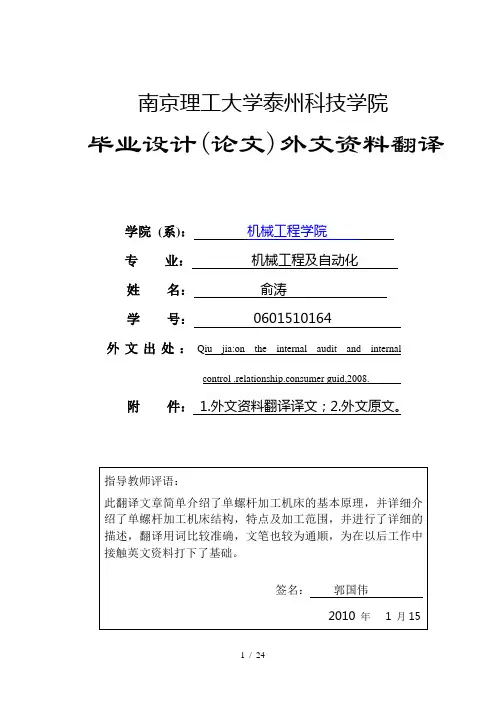
南京理工大学泰州科技学院毕业设计(论文)外文资料翻译学院(系):机械工程学院专业:机械工程及自动化姓名:俞涛学号:0601510164外文出处:Qiu jia:on the internal audit and internalcontrol .relationship.consumer guid,2008.附件:1.外文资料翻译译文;2.外文原文。
注:请将该封面与附件装订成册。
附件1:外文资料翻译译文单螺杆加工机床的布局和结构摘要本文从四个方面介绍了国内现有单螺杆加工机床的布局和结构,并把优缺点一一列举出来,由于压缩机生产厂的单螺杆加工机床和机床资料对外保密,以上介绍难免有片面、不妥之处,因此仅供单螺杆压缩机生产厂参考。
关键词机床主轴轴承刀具机床是一个国家制造业水平高低的象征,其核心就是数控系统。
我们目前不要说系统,就是国内造的质量稍微好一点的数控机床,所用的高精度滚珠丝杠,轴承都是进口的,主要是买日本的,我们自产的滚珠丝杠、轴承在精度、寿命方面都有问题。
目前国内的各大机床厂,数控系统100%外购,各厂家一般都买日本发那科、三菱的系统,占80%以上,也有德国西门子的系统,但比较少。
德国西门子系统为什么用的少呢?早期,德国系统不太能适合我们的电网,我们的电网稳定性不够,西门子系统的电子伺服模块容易烧坏。
日本就不同了,他们的系统就烧不坏。
近来西门子系统改进了不少,价格方面还是略高。
德国人很不重视中国,所以他们的系统汉语化最近才有,不像日本,老早就有汉语化版的。
韩国、台湾的数控机床制造能力比大陆地区略强,不过水平差不多。
他们也是在上世纪90年代引进日本技术发展的。
韩国应该好一点,它有自己制造的、已经商业化了的数控系统,但进口到中国的机床,应我们的要求,也换成了日本系统。
我们对他们的系统信不过。
韩国数控机床主要有两家:大宇和现代。
大宇目前在我国设有合资企业。
台湾机床和我们大体一样,自己造机械部分,系统采购日本的。
毕业设计(论文)外文资料翻译(学生用)
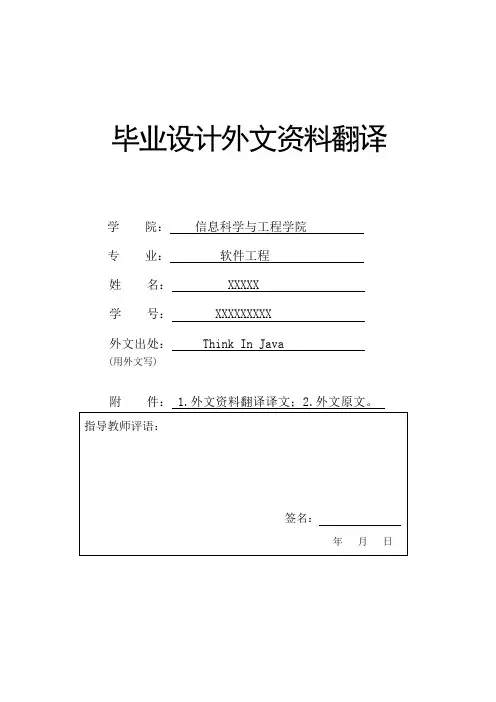
毕业设计外文资料翻译学院:信息科学与工程学院专业:软件工程姓名: XXXXX学号: XXXXXXXXX外文出处: Think In Java (用外文写)附件: 1.外文资料翻译译文;2.外文原文。
附件1:外文资料翻译译文网络编程历史上的网络编程都倾向于困难、复杂,而且极易出错。
程序员必须掌握与网络有关的大量细节,有时甚至要对硬件有深刻的认识。
一般地,我们需要理解连网协议中不同的“层”(Layer)。
而且对于每个连网库,一般都包含了数量众多的函数,分别涉及信息块的连接、打包和拆包;这些块的来回运输;以及握手等等。
这是一项令人痛苦的工作。
但是,连网本身的概念并不是很难。
我们想获得位于其他地方某台机器上的信息,并把它们移到这儿;或者相反。
这与读写文件非常相似,只是文件存在于远程机器上,而且远程机器有权决定如何处理我们请求或者发送的数据。
Java最出色的一个地方就是它的“无痛苦连网”概念。
有关连网的基层细节已被尽可能地提取出去,并隐藏在JVM以及Java的本机安装系统里进行控制。
我们使用的编程模型是一个文件的模型;事实上,网络连接(一个“套接字”)已被封装到系统对象里,所以可象对其他数据流那样采用同样的方法调用。
除此以外,在我们处理另一个连网问题——同时控制多个网络连接——的时候,Java内建的多线程机制也是十分方便的。
本章将用一系列易懂的例子解释Java的连网支持。
15.1 机器的标识当然,为了分辨来自别处的一台机器,以及为了保证自己连接的是希望的那台机器,必须有一种机制能独一无二地标识出网络内的每台机器。
早期网络只解决了如何在本地网络环境中为机器提供唯一的名字。
但Java面向的是整个因特网,这要求用一种机制对来自世界各地的机器进行标识。
为达到这个目的,我们采用了IP(互联网地址)的概念。
IP以两种形式存在着:(1) 大家最熟悉的DNS(域名服务)形式。
我自己的域名是。
所以假定我在自己的域内有一台名为Opus的计算机,它的域名就可以是。
毕业设计(论文)外文资料翻译
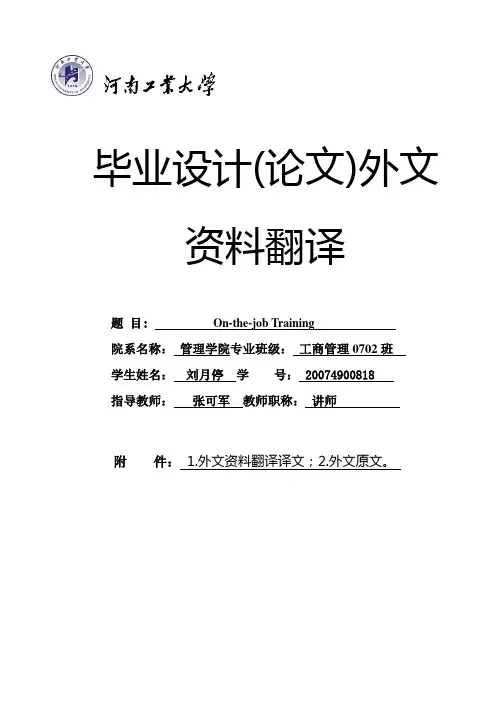
毕业设计(论文)外文资料翻译题目:On-the-job Training院系名称:管理学院专业班级:工商管理0702班学生姓名:刘月停学号: 20074900818指导教师:张可军教师职称:讲师附件: 1.外文资料翻译译文;2.外文原文。
附件1:外文资料翻译译文在职培训在职培训一般是在正常工作条件下对工作技能的培训。
通过在职培训,工人可以掌握一般技能,是可以从一个工作转移到另一个工作的技能。
关于在职训练,通常包括口头和书面指示,示范和观察,动手实践和模仿。
此外,对在职员工的培训过程涉及一个通常是主管或有经验的员工传递知识和技能到一个新手。
在职培训是最古老的培训形式之一。
此前,异地培训教室的出现,唯一的任务是一起学习某一行业或专业,是学徒的做法,在中世纪时,有经验的工匠和新手一起工作教授新员工实用的方法和知识。
在职培训是一种职业培训,在美国它是一种对非管理雇员培训的主要形式。
许多研究表明,它是最有效的职业培训形式。
在职培训大部分是由私营部门提供,但最广泛的研究培训计划由联邦立法的赞助。
在职培训程序从公司监事正规培训到观察学习。
从这个意义上说,在职培训最正式的类型是课堂培训,他们主要在企业内部不同的部门进行。
在国际竞争更广泛的电脑生产过程中使用,更正式更复杂的在职培训的落实已成为在美国公司的关键问题。
在职培训的类型两个不同类型的关于在职培训的频繁杰出的专业文献:结构(计划)和非结构化(计划外)。
非结构是最常见的一种,泛指在职培训主要涉及一个新手与经验丰富的员工的工作,新手在导师的观察下模仿训练的过程。
新工人主要通过试验和学习的方法向经验丰富的工人或者监事学习。
非结构化培训的工作(如产品制造)的要求很低,并不像传授工作技能(如生产产品所需的特定技能)的新工人培训。
因此,非结构化的在职培训往往不能完全按需要的技能传授或持续,因为有经验的员工,有时无法清楚表达执行工作的正确方法,他们每次训练新工人时会使用不同的训练方法。
关于正当防卫的外文文献资料及翻译
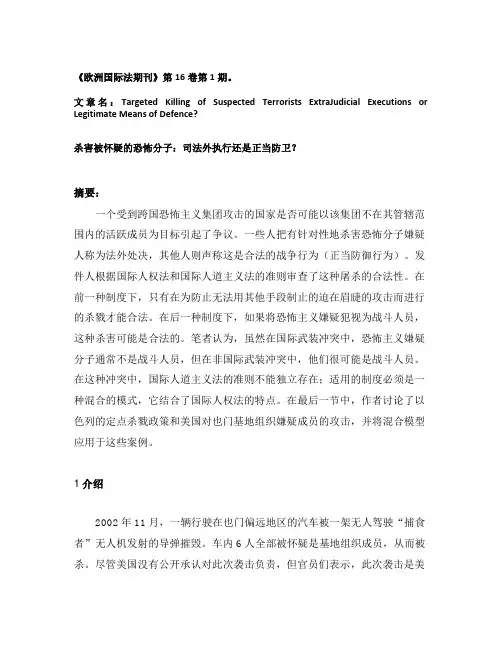
《欧洲国际法期刊》第16卷第1期。
文章名:Targeted Killing of Suspected Terrorists ExtraJudicial Executions or Legitimate Means of Defence?杀害被怀疑的恐怖分子:司法外执行还是正当防卫?摘要:一个受到跨国恐怖主义集团攻击的国家是否可能以该集团不在其管辖范围内的活跃成员为目标引起了争议。
一些人把有针对性地杀害恐怖分子嫌疑人称为法外处决,其他人则声称这是合法的战争行为(正当防御行为)。
发件人根据国际人权法和国际人道主义法的准则审查了这种屠杀的合法性。
在前一种制度下,只有在为防止无法用其他手段制止的迫在眉睫的攻击而进行的杀戮才能合法。
在后一种制度下,如果将恐怖主义嫌疑犯视为战斗人员,这种杀害可能是合法的。
笔者认为,虽然在国际武装冲突中,恐怖主义嫌疑分子通常不是战斗人员,但在非国际武装冲突中,他们很可能是战斗人员。
在这种冲突中,国际人道主义法的准则不能独立存在;适用的制度必须是一种混合的模式,它结合了国际人权法的特点。
在最后一节中,作者讨论了以色列的定点杀戮政策和美国对也门基地组织嫌疑成员的攻击,并将混合模型应用于这些案例。
1介绍2002年11月,一辆行驶在也门偏远地区的汽车被一架无人驾驶“捕食者”无人机发射的导弹摧毁。
车内6人全部被怀疑是基地组织成员,从而被杀。
尽管美国没有公开承认对此次袭击负责,但官员们表示,此次袭击是美国中央情报局所为。
被击毙的其中一人名叫卡伊德·萨利姆,据说是前本拉登的一名保安,他被怀疑在2000年10月美国“科尔”号驱逐舰遇袭事件中扮演了重要角色。
两年前,以色列采取了一项“有针对性地害”巴勒斯坦人的政策,据称这些巴勒斯坦人是参与组织、促进或执行在以色列和被占领领土上的恐怖主义袭击的恐怖主义组织的积极成员。
这一政策始于对侯赛因的阿巴亚特的袭击,随后发生了一系列袭击,最近最严重的是对哈马斯领导人艾哈迈德·亚辛和阿卜杜勒·阿齐兹·兰蒂西的袭击。
外文参考文献(带中文翻译)
外文资料原文涂敏之会计学 8051208076Title:Future of SME finance(c)Background – the environment for SME finance has changedFuture economic recovery will depend on the possibility of Crafts, Trades and SMEs to exploit their potential for growth and employment creation.SMEs make a major contribution to growth and employment in the EU and are at the heart of the Lisbon Strategy, whose main objective is to turn Europe into the most competitive and dynamic knowledge-based economy in the world. However, the ability of SMEs to grow depends highly on their potential to invest in restructuring, innovation and qualification. All of these investments need capital and therefore access to finance.Against this background the consistently repeated complaint of SMEs about their problems regarding access to finance is a highly relevant constraint that endangers the economic recovery of Europe.Changes in the finance sector influence the behavior of credit institutes towards Crafts, Trades and SMEs. Recent and ongoing developments in the banking sector add to the concerns of SMEs and will further endanger their access to finance. The main changes in the banking sector which influence SME finance are:•Globalization and internationalization have increased the competition and the profit orientation in the sector;•worsening of the economic situations in some institutes (burst of the ITC bubble, insolvencies) strengthen the focus on profitability further;•Mergers and restructuring created larger structures and many local branches, which had direct and personalized contacts with small enterprises, were closed;•up-coming implementation of new capital adequacy rules (Basel II) will also change SME business of the credit sector and will increase its administrative costs;•Stricter interpretation of State-Aide Rules by the European Commission eliminates the support of banks by public guarantees; many of the effected banks are very active in SME finance.All these changes result in a higher sensitivity for risks and profits in the financesector.The changes in the finance sector affect the accessibility of SMEs to finance.Higher risk awareness in the credit sector, a stronger focus on profitability and the ongoing restructuring in the finance sector change the framework for SME finance and influence the accessibility of SMEs to finance. The most important changes are: •In order to make the higher risk awareness operational, the credit sector introduces new rating systems and instruments for credit scoring;•Risk assessment of SMEs by banks will force the enterprises to present more and better quality information on their businesses;•Banks will try to pass through their additional costs for implementing and running the new capital regulations (Basel II) to their business clients;•due to the increase of competition on interest rates, the bank sector demands more and higher fees for its services (administration of accounts, payments systems, etc.), which are not only additional costs for SMEs but also limit their liquidity;•Small enterprises will lose their personal relationship with decision-makers in local branches –the credit application process will become more formal and anonymous and will probably lose longer;•the credit sector will lose more and more i ts “public function” to provide access to finance for a wide range of economic actors, which it has in a number of countries, in order to support and facilitate economic growth; the profitability of lending becomes the main focus of private credit institutions.All of these developments will make access to finance for SMEs even more difficult and / or will increase the cost of external finance. Business start-ups and SMEs, which want to enter new markets, may especially suffer from shortages regarding finance. A European Code of Conduct between Banks and SMEs would have allowed at least more transparency in the relations between Banks and SMEs and UEAPME regrets that the bank sector was not able to agree on such a commitment.Towards an encompassing policy approach to improve the access of Crafts, Trades and SMEs to financeAll analyses show that credits and loans will stay the main source of finance for the SME sector in Europe. Access to finance was always a main concern for SMEs, but the recent developments in the finance sector worsen the situation even more.Shortage of finance is already a relevant factor, which hinders economic recovery in Europe. Many SMEs are not able to finance their needs for investment.Therefore, UEAPME expects the new European Commission and the new European Parliament to strengthen their efforts to improve the framework conditions for SME finance. Europe’s Crafts, Trades and SMEs ask for an encompassing policy approach, which includes not only the conditions for SMEs’ access to l ending, but will also strengthen their capacity for internal finance and their access to external risk capital.From UEAPME’s point of view such an encompassing approach should be based on three guiding principles:•Risk-sharing between private investors, financial institutes, SMEs and public sector;•Increase of transparency of SMEs towards their external investors and lenders;•improving the regulatory environment for SME finance.Based on these principles and against the background of the changing environment for SME finance, UEAPME proposes policy measures in the following areas:1. New Capital Requirement Directive: SME friendly implementation of Basel IIDue to intensive lobbying activities, UEAPME, together with other Business Associations in Europe, has achieved some improvements in favour of SMEs regarding the new Basel Agreement on regulatory capital (Basel II). The final agreement from the Basel Committee contains a much more realistic approach toward the real risk situation of SME lending for the finance market and will allow the necessary room for adaptations, which respect the different regional traditions and institutional structures.However, the new regulatory system will influence the relations between Banks and SMEs and it will depend very much on the way it will be implemented into European law, whether Basel II becomes burdensome for SMEs and if it will reduce access to finance for them.The new Capital Accord form the Basel Committee gives the financial market authorities and herewith the European Institutions, a lot of flexibility. In about 70 areas they have room to adapt the Accord to their specific needs when implementing itinto EU law. Some of them will have important effects on the costs and the accessibility of finance for SMEs.UEAPME expects therefore from the new European Commission and the new European Parliament:•The implementation of the new Capital Requirement Directive will be costly for the Finance Sector (up to 30 Billion Euro till 2006) and its clients will have to pay for it. Therefore, the implementation – especially for smaller banks, which are often very active in SME finance –has to be carried out with as little administrative burdensome as possible (reporting obligations, statistics, etc.).•The European Regulators must recognize traditional instruments for collaterals (guarantees, etc.) as far as possible.•The European Commission and later the Member States should take over the recommendations from the European Parliament with regard to granularity, access to retail portfolio, maturity, partial use, adaptation of thresholds, etc., which will ease the burden on SME finance.2. SMEs need transparent rating proceduresDue to higher risk awareness of the finance sector and the needs of Basel II, many SMEs will be confronted for the first time with internal rating procedures or credit scoring systems by their banks. The bank will require more and better quality information from their clients and will assess them in a new way. Both up-coming developments are already causing increasing uncertainty amongst SMEs.In order to reduce this uncertainty and to allow SMEs to understand the principles of the new risk assessment, UEAPME demands transparent rating procedures –rating procedures may not become a “Black Box” for SMEs: •The bank should communicate the relevant criteria affecting the rating of SMEs.•The bank should inform SMEs about its assessment in order to allow SMEs to improve.The negotiations on a European Code of Conduct between Banks and SMEs , which would have included a self-commitment for transparent rating procedures by Banks, failed. Therefore, UEAPME expects from the new European Commission and the new European Parliament support for:•binding rules in the framework of the new Capital Adequacy Directive,which ensure the transparency of rating procedures and credit scoring systems for SMEs;•Elaboration of national Codes of Conduct in order to improve the relations between Banks and SMEs and to support the adaptation of SMEs to the new financial environment.3. SMEs need an extension of credit guarantee systems with a special focus on Micro-LendingBusiness start-ups, the transfer of businesses and innovative fast growth SMEs also depended in the past very often on public support to get access to finance. Increasing risk awareness by banks and the stricter interpretation of State Aid Rules will further increase the need for public support.Already now, there are credit guarantee schemes in many countries on the limit of their capacity and too many investment projects cannot be realized by SMEs.Experiences show that Public money, spent for supporting credit guarantees systems, is a very efficient instrument and has a much higher multiplying effect than other instruments. One Euro form the European Investment Funds can stimulate 30 Euro investments in SMEs (for venture capital funds the relation is only 1:2).Therefore, UEAPME expects the new European Commission and the new European Parliament to support:•The extension of funds for national credit guarantees schemes in the framework of the new Multi-Annual Programmed for Enterprises;•The development of new instruments for securitizations of SME portfolios;•The recognition of existing and well functioning credit guarantees schemes as collateral;•More flexibility within the European Instruments, because of national differences in the situation of SME finance;•The development of credit guarantees schemes in the new Member States;•The development of an SBIC-like scheme in the Member States to close the equity gap (0.2 – 2.5 Mio Euro, according to the expert meeting on PACE on April 27 in Luxemburg).•the development of a financial support scheme to encourage the internalizations of SMEs (currently there is no scheme available at EU level: termination of JOP, fading out of JEV).4. SMEs need company and income taxation systems, whichstrengthen their capacity for self-financingMany EU Member States have company and income taxation systems with negative incentives to build-up capital within the company by re-investing their profits. This is especially true for companies, which have to pay income taxes. Already in the past tax-regimes was one of the reasons for the higher dependence of Europe’s SMEs on bank lending. In future, the result of rating w ill also depend on the amount of capital in the company; the high dependence on lending will influence the access to lending. This is a vicious cycle, which has to be broken.Even though company and income taxation falls under the competence of Member States, UEAPME asks the new European Commission and the new European Parliament to publicly support tax-reforms, which will strengthen the capacity of Crafts, Trades and SME for self-financing. Thereby, a special focus on non-corporate companies is needed.5. Risk Capital – equity financingExternal equity financing does not have a real tradition in the SME sector. On the one hand, small enterprises and family business in general have traditionally not been very open towards external equity financing and are not used to informing transparently about their business.On the other hand, many investors of venture capital and similar forms of equity finance are very reluctant regarding investing their funds in smaller companies, which is more costly than investing bigger amounts in larger companies. Furthermore it is much more difficult to set out of such investments in smaller companies.Even though equity financing will never become the main source of financing for SMEs, it is an important instrument for highly innovative start-ups and fast growing companies and it has therefore to be further developed. UEAPME sees three pillars for such an approach where policy support is needed:Availability of venture capital•The Member States should review their taxation systems in order to create incentives to invest private money in all forms of venture capital.•Guarantee instruments for equity financing should be further developed.Improve the conditions for investing venture capital into SMEs•The development of secondary markets for venture capital investments in SMEs should be supported.•Accounting Standards for SMEs should be revised in order to easetransparent exchange of information between investor and owner-manager.Owner-managers must become more aware about the need for transparency towards investors•SME owners will have to realise that in future access to external finance (venture capital or lending) will depend much more on a transparent and open exchange of information about the situation and the perspectives of their companies.•In order to fulfil the new needs for transparency, SMEs will have to use new information instruments (business plans, financial reporting, etc.) and new management instruments (risk-management, financial management, etc.).外文资料翻译涂敏之会计学 8051208076题目:未来的中小企业融资背景:中小企业融资已经改变未来的经济复苏将取决于能否工艺品,贸易和中小企业利用其潜在的增长和创造就业。
减速器论文中英文对照资料外文翻译文献
减速器论文中英文对照资料外文翻译文献What is a Gearbox?A XXX.1.The n of a Gearbox1) The gearbox ces the speed while increasing the output torque。
The torque output。
is the motor output multiplied by the n。
but it should not exceed the XXX.2) The gearbox also ces the inertia of the load。
which decreases by the square of the n。
Most motors have an inertia value that can be XXX.2.Types of GearboxesCommon gearboxes include bevel gear cers (including parallel-axis bevel gear cers。
worm gear cers。
and cone gear cers)。
ary gear cers。
cycloid cers。
worm gear cers。
XXX.mon Gearboxes1) The main feature of the worm gear cer is its reverse self-locking n。
which can achieve a large n。
The input and output shafts are not on the same axis or in the same plane。
However。
it generally has a large volume。
low n efficiency。
and low n.2) XXX and power。
It has a small size and high n。
生物科学论文中英文资料外文翻译文献
生物科学论文中英文资料外文翻译文献Carotenoid Biosynthetic Pathway in the Citrus Genus: Number of Copies and Phylogenetic Diversity of Seven GeneThe first objective of this paper was to analyze the potential role of allelic variability of carotenoid biosynthetic genes in the interspecifi diversity in carotenoid composition of Citrus juices. The second objective was to determine the number of copies for each of these genes. Seven carotenoid biosynthetic genes were analyzed using restriction fragment length polymorphism (RFLP) and simple sequence repeats (SSR) markers. RFLP analyses were performed with the genomic DNA obtained from 25 Citrus genotypes using several restriction enzymes. cDNA fragments of Psy, Pds, Zds, Lcyb, Lcy-e, Hy-b, and Zep genes labeled with [R-32P]dCTP were used as probes. For SSR analyses, two primer pairs amplifying two SSR sequences identified from expressed sequence tags (ESTs) of Lcy-b and Hy-b genes were designed. The number of copies of the seven genes ranged from one for Lcy-b to three for Zds. The genetic diversity revealed by RFLP and SSR profiles was in agreement with the genetic diversity obtained from neutral molecμLar markers. Genetic interpretation of RFLP and SSR profiles of four genes (Psy1, Pds1, Lcy-b, and Lcy-e1) enabled us to make inferences on the phylogenetic origin of alleles for the major commercial citrus species. Moreover, the resμLts of our analyses suggest that the allelic diversity observed at the locus of both of lycopene cyclase genes, Lcy-b and Lcy-e1, is associated with interspecific diversity in carotenoid accumμLation in Citrus. The interspecific differences in carotenoid contents previously reported to be associated withother key steps catalyzed by PSY, HY-b, and ZEP were not linked to specific alleles at the corresponding loci.KEYWORDS: Citrus; carotenoids; biosynthetic genes; allelic variability; phylogeny INTRODUCTIONCarotenoids are pigments common to all photosynthetic organisms. In pigment-protein complexes, they act as light sensors for photosynthesis but also prevent photo-oxidat ion induced by too strong light intensities. In horticμLtural crops, they play a major role in fruit, root, or tuber coloration and in nutritional quality. Indeed some of these micronutrients are precursors of vitamin A, an essential component of human and animal diets. Carotenoids may also play a role in chronic disease prevention (such as certain cancers), probably due to their antioxidant properties. The carotenoid biosynthetic pathway is now well established. Carotenoids are synthesized in plastids by nuclear-encoded enzymes. The immediate precursor of carotenoids (and also of gibberellins, plastoquinone, chlorophylls,phylloquinones, and tocopherols) is geranylgeranyl diphosphate (GGPP). In light-grown plants, GGPP is mainly derivedcarotenoid, 15-cis-phytoene. Phytoene undergoes four desaturation reactions catalyzed by two enzymes, phytoene desaturase (PDS) and β-carotene desaturase (ZDS), which convert phytoene into the red-colored poly-cis-lycopene. Recently, Isaacson et al. and Park et al. isolated from tomato and Arabidopsis thaliana, respectively, the genes that encode the carotenoid isomerase (CRTISO) which, in turn, catalyzes the isomerization of poly-cis-carotenoids into all-trans-carotenoids. CRTISO acts on prolycopene to form all-trans lycopene, which undergoes cyclization reactions. Cyclization of lycopene is abranching point: one branch leads to β-carotene (β, β-carotene) and the other toα-carotene (β, ε-carotene). Lycopene β-cyclase (LCY-b) then converts lycopene intoβ-carotene in two steps, whereas the formation of α-carotene requires the action of two enzymes, lycopene ε- cyclase (LCY-e) and lycopene β-cyclase (LCY-b). α- carotene is converted into lutein by hydroxylations catalyzed by ε-carotene hydroxylase (HY-e) andβ-carotene hydroxylase (HY-b). Other xanthophylls are produced fromβ-carotene with hydroxylation reactions catalyzed by HY-b and epoxydation catalyzed by zeaxanthin epoxidase (ZEP). Most of the carotenoid biosynthetic genes have been cloned and sequenced in Citrus varieties . However, our knowledge of the complex regμLation of carotenoid biosynthesis in Citrus fruit is still limited. We need further information on the number of copies of these genes and on their allelic diversity in Citrus because these can influence carotenoid composition within the Citrus genus.Citrus fruit are among the richest sources of carotenoids. The fruit generally display a complex carotenoid structure, and 115 different carotenoids have been identified in Citrus fruit. The carotenoid richness of Citrus flesh depends on environmental conditions, particμLarly on growing conditions and on geogr aphical origin . However the main factor influencing variability of caro tenoid quality in juice has been shown to be genetic diversity. Kato et al. showed that mandarin and orange juices accumμLated high levels of β-cryptoxanthin and violaxanthin, respectively, whereas mature lemon accumμLated extremely low levels of carotenoids. Goodner et al. demonstrated that mandarins, oranges, and their hybrids coμLd be clearly distinguished by theirβ-cryptoxanthin contents. Juices of red grapefruit contained two major carotenoids: lycopene and β-carotene. More recently, we conducted a broad study on the organization of the variability of carotenoid contents in different cμLtivated Citrus species in relation with the biosynthetic pathway . Qualitative analysis of presence or absence of the different compounds revealed three main clusters: (1) mandarins, sweet oranges, and sour oranges;(2) citrons, lemons, and limes; (3) pummelos and grapefruit. Our study also enabled identification of key steps in the diversification of the carotenoid profile. Synthesis of phytoene appeared as a limiti ng step for acid Citrus, while formation of β-carotene and R-carotene from lycopene were dramatically limited in cluster 3 (pummelos and grapefruit). Only varieties in cluster 1 were able to produce violaxanthin. In the same study , we concluded that there was a very strong correlation between the classification of Citrus species based on the presence or absence of carotenoids (below,this classification is also referred to as the organization of carotenoid diversity) and genetic diversity evaluated with bi ochemical or molecμLar markers such as isozymes or randomLy amplified polymorphic DNA (RAPD). We also concluded that, at the interspecific level, the organization of the diversity of carotenoid composition was linked to the global evolution process of cμLt ivated Citrus rather than to more recent mutation events or human selection processes. Indeed, at interspecific level, a correlation between phenotypic variability and genetic diversity is common and is generally associated with generalized gametic is common and is generally associated with generalized gametic disequilibrium resμLting from the history of cμLtivated Citrus. Thus from numerical taxonomy based on morphologicaltraits or from analysis of molecμLar markers , all authors agreed on the existence o f three basic taxa (C. reticμLata, mandarins; C. medica, citrons; and C. maxima, pummelos) whose differentiation was the resμLt of allopatric evolution. All other cμLtivated Citrus specie s (C. sinensis, sweet oranges; C. aurantium, sour oranges;C. paradi si, grapefruit; and C. limon, lemons) resμLted from hybridization events within this basic pool except for C. aurantifolia, which may be a hybrid between C. medica and C. micrantha .Our p revious resμLts and data on Citrus evolution lead us to propose the hypothesis that the allelic variability supporting the organization of carotenoid diversity at interspecific level preceded events that resμLted in the creation of secondary species. Such molecμLar variability may have two different effects: on the one hand, non-silent substitutions in coding region affect the specific activity of corresponding enzymes of the biosynthetic pathway, and on the other hand, variations in untranslated regions affect transcriptional or post-transcriptional mechanisms.There is no available data on the allelic diversity of Citrus genes of the carotenoid biosynthetic pathway. The objective of this paper was to test the hypothesis that allelic variability of these genes partially determines phenotypic variability at the interspecific level. For this purpose, we analyzed the RFLPs around seven genes of the biosynthetic pathway of carotenoids (Psy, Pds, Zds, Lcy-b, Lcy-e, Hy-b, Zep) and the polymorphism of two SSR sequences found in Lcy-b and Hy-b genes in a representative set of varieties of the Citrus genus already analyzed for carotenoid constitution. Our study aimed to answer the following questions: (a) are those genes mono- or mμLtilocus, (b) is the polymorphism revealed by RFLP and SSR markers inagreement with the general histor y of cμLtivated Citrus thus permitting inferences about the phylogenetic origin of genes of the secondary species, and (c) is this polymorphism associated with phenotypic (carotenoid compound) variations.RESΜLTS AND DISCUSSIONGlobal Diversity of the Genotype Sample Observed by RFLP Analysis. RFLP analyses were performed using probes defined from expressed sequences of seven major genes of the carotenoid biosynthetic pathway . One or two restriction enzymes were used for each gene. None of these enzymes cut the cDNA probe sequence except HindIII for the Lcy-e gene. Intronic sequences and restriction sites on genomic sequences werescreened with PCR amplification using genomic DNA as template and with digestion of PCR products. The resμLts indicated the absence of an intronic sequence for Psy and Lcy-b fragments. The absence of intron in these two fragments was checked by cloning and sequencing corresponding genomic sequences (data not shown). Conversely, we found introns in Pds, Zds, Hy-b, Zep, and Lcy-e genomic sequences corresponding to RFLP probes. EcoRV did not cut the genomic sequences of Pds, Zds, Hy-b, Zep, and Lcy-e. In the same way, no BamHI restriction site was found in the genomic sequences of Pds, Zds, and Hy-b. Data relative to the diversity observed for the different genes are presented in Table 4. A total of 58 fragments were identified, six of them being monomorphic (present in all individuals). In the limited sample of the three basic taxa, only eight bands out of 58 coμLd not be observed. In the basic taxa, the mean number of bands per genotype observed was 24.7, 24.7, and 17 for C. reticμLata, C. maxima, and C. medica, respectively. It varies from28 (C. limettioides) to 36 (C. aurantium) for the secondary species. The mean number of RFLP bands per individual was lower for basic taxa than for the group of secondary species. This resμLt indicates that secondary species are much more heterozygous than the basic ones for these genes, which is logical if we assume that the secondary species arise from hybridizations between the three basic taxa. Moreover C. medica appears to be the least heterozygous taxon for RFLP around the genes of the carotenoid biosynthetic pathway, as already shown with isozymes, RAPD, and SSR markers.The two lemons were close to the acid Citrus cluster and the three sour oranges close to the mandarins/sweet oranges cluster. This organization of genetic diversity based on the RFLP profiles obtained with seven genes of the carotenoid pathway is very similar to that previously obtained with neutral molecμLar markers such as genomic SSR as well as the organization obtained with qualitative carotenoid compositions. All these resμLts suggest that the observed RFLP and SSR fragments are good phylogenetic markers. It seems consistent with our basic hypothesis that major differentiation in the genes involved in the carotenoid biosynthetic pathway preceded the creation of the secondary hybrid species and thus that the allelic structure of these hybrid species can be reconstructed from alleles observed in the three basic taxa.Gene by Gene Analysis: The Psy Gene. For the Psy probe combined with EcoRV or BamHI restriction enzymes, five bands were identified for the two enzymes, and two to three bands were observed for each genotype. One of these bands was present in all individuals. There was no restriction site in the probe sequence. These resμLts lead us to believe that Psy is present at two loci,one where no polymorphism was found with the restriction enzymes used, and one that displayed polymorphism. The number of different profiles observed was six and four with EcoRV and BamHI, respectively, for a total of 10 different profiles among the 25 individuals .Two Psy genes have also been found in tomato, tobacco, maize, and rice . Conversely, only one Psy gene has been found in Arabidopsis thaliana and in pepper (Capsicum annuum), which also accumμLates carotenoids in fruit. According to Bartley and Scolnik, Psy1 was expressed in tomato fruit chromoplasts, while Psy2 was specific to leaf tissue. In the same way, in Poaceae (maize, rice), Gallagher et al. found that Psy gene was duplicated and that Psy1 and notPsy2 transcripts in endosperm correlated with endosperm carotenoid accumμLation. These resμLts underline the role of gene duplication and the importance of tissue-specific phytoene synthase in the regμLation of carotenoid accumμLation.All the polymorphic bands were present in the sample of the basic taxon genomes. Assuming the hypothesis that all these bands describe the polymorphism at the same locus for the Psy gene, we can conclude that we found allelic differentiation between the three basic taxa with three alleles for C. reticμLata, four for C. maxima, and one for C. medica.The alleles observed for the basic taxa then enabled us to determine the genotypes of all the other species. The presumed genotypes for the Psy polymorphic locus are given in Table 7. Sweet oranges and grapefruit were heterozygous with one mandarin and one pummelo allele. Sour oranges were heterozygous; they shared the same mandarin allele with sweet oranges but had a different pummelo allele. Clementine was heterozygous with two mandarin alleles; one shared with sweetoranges and one with “Willow leaf” mandarin. “Meyer” lemon was heterozygous, with the mandarin allele also found in sweet oranges, and the citron allele. “Eureka”lemon was also heterozygous with the same pummelo allele as sour oranges and the citron allele. The other acid Citrus were homozygous for the citron allele.The Pds Gen. For the Pds probe combined with EcoRV, six different fragments were observed. One was common to all individuals. The number of fragments per individual was two or three. ResμLts for Pds led us to believe that this gene is present at two loci, one where no polymorphism was found with EcoRV restriction, and one displaying polymorphism. Conversely, studies on Arabidopsis, tomato, maize, and rice showed that Pds was a single copy gene. However, a previous study on Citrus suggests that Pds is present as a low-copy gene family in the Citrus genome, which is in agreement with our findings.The Zds Gene. The Zds profiles were complex. Nine and five fragments were observed with EcoRV and BamHI restriction, respectively. For both enzymes, one fragment was common to all individuals. The number of fragments per individual ranged from two to six for EcoRV and three to five for BamHI. There was no restriction site in the probe sequence. It can be assumed that several copies (at least three) of the Zds gene are present in the Citrus genome with polymorphism for at least two of them. In Arabidopsis, maize, and rice, like Pds, Zds was a single-copy gene .In these conditions and in the absence of analysis of controlled progenies, we are unable to conduct genetic analysis of profiles. However it appears that some bands differentiated the basic taxa: one for mandarins, one for pummelos, and one for citrons with EcoRV restriction and one for pummelos and onefor citrons with BamHI restriction. Two bands out of the nine obtained with EcoRV were not observed in the samples of basic taxa. One was rare and only observed in “Rangpur” lime. The other was found in sour oranges, “V olkamer” lemon,and “Palestine sweet” lime suggesting a common ancestor for these three genotypes.This is in agreement with the assumption of Nicolosi et al. that “V olkamer” lemon resμLts from a complex hybrid combination with C. aurantium as one parent. It will be necessary to extend the analysis of the basic taxa to conclude whether these specific bands are present in the diversity of these taxa or resμLt from mutations after the formation of the secondary species.The Lcy-b Gene with RFLP Analysis.After restriction with EcoRV and hybridization with the Lcy-b probe, we obtained simple profiles with a total of four fragments. One to two fragments were observed for each individual, and seven profiles were differentiated among the 25 genotypes. These resμLts provide evidence that Lcy-b is present at a single locus in the haploid Citrus genome. Two lycopene β-cyclases encoded by two genes have been identified in tomato. The B gene encoded a novel type of lycopene β-cyclase whose sequence was similar to capsanthin-capsorubin synthase. The B gene expressed at a high level in βmutants was responsible for strong accumμLation ofβ-carotene in fruit, while in wild-type tomatoes, B was expressed at a low level.The Lcy-b Gene with SSR Analysis. Four bands were detected at locus 1210 (Lcy-b gene). One or two bands were detected per variety confirming that this gene is mono locus. Six different profiles were observed among the 25 genotypes. As with RFLPanalysis, no intrataxon molecμLar polymorphism was found within C. Paradisi, C. Sinensis, and C. Aurantium.Taken together, the information obtained from RFLP and SSR analyses enabled us to identify a complete differentiation among the three basic taxon samples. Each of these taxons displayed two alleles for the analyzed sample. An additional allele was identified for “Mexican” l ime. The profiles for all secondary species can be reconstructed from these alleles. Deduced genetic structure is given in. Sweet oranges and clementine were heterozygous with one mandarin and one pummelo allele. Sour oranges were also heterozygous sharing the same mandarin allele as sweet oranges but with another pummelo allele. Grapefruit were heterozygous with two pummelo alleles. All the acid secondary species were heterozygous, having one allele from citrons and the other one from mandarins except for “Mexican” lime, which had a specific allele.柑桔属类胡萝卜素生物合成途径中七个基因拷贝数目及遗传多样性的分析摘要:本文的首要目标是分析类胡萝卜素生物合成相关等位基因在发生变异柑橘属类胡萝卜素组分种间差异的潜在作用;第二个目标是确定这些基因的拷贝数。
毕业设计(论文)外文资料翻译【范本模板】
南京理工大学紫金学院毕业设计(论文)外文资料翻译系:机械系专业:车辆工程专业姓名:宋磊春学号:070102234外文出处:EDU_E_CAT_VBA_FF_V5R9(用外文写)附件:1。
外文资料翻译译文;2.外文原文.附件1:外文资料翻译译文CATIA V5 的自动化CATIA V5的自动化和脚本:在NT 和Unix上:脚本允许你用宏指令以非常简单的方式计划CATIA。
CATIA 使用在MS –VBScript中(V5.x中在NT和UNIX3。
0 )的共用部分来使得在两个平台上运行相同的宏。
在NT 平台上:自动化允许CATIA像Word/Excel或者Visual Basic程序那样与其他外用分享目标。
ATIA 能使用Word/Excel对象就像Word/Excel能使用CATIA 对象。
在Unix 平台上:CATIA将来的版本将允许从Java分享它的对象。
这将提供在Unix 和NT 之间的一个完美兼容。
CATIA V5 自动化:介绍(仅限NT)自动化允许在几个进程之间的联系:CATIA V5 在NT 上:接口COM:Visual Basic 脚本(对宏来说),Visual Basic 为应用(适合前:Word/Excel ),Visual Basic。
COM(零部件目标模型)是“微软“标准于几个应用程序之间的共享对象。
Automation 是一种“微软“技术,它使用一种解释环境中的COM对象。
ActiveX 组成部分是“微软“标准于几个应用程序之间的共享对象,即使在解释环境里。
OLE(对象的链接与嵌入)意思是资料可以在一个其他应用OLE的资料里连结并且可以被编辑的方法(在适当的位置编辑).在VBScript,VBA和Visual Basic之间的差别:Visual Basic(VB)是全部的版本。
它能产生独立的计划,它也能建立ActiveX 和服务器。
它可以被编辑。
VB中提供了一个补充文件名为“在线丛书“(VB的5。
- 1、下载文档前请自行甄别文档内容的完整性,平台不提供额外的编辑、内容补充、找答案等附加服务。
- 2、"仅部分预览"的文档,不可在线预览部分如存在完整性等问题,可反馈申请退款(可完整预览的文档不适用该条件!)。
- 3、如文档侵犯您的权益,请联系客服反馈,我们会尽快为您处理(人工客服工作时间:9:00-18:30)。
一种基于数字信号处理器的温度补偿测量系统光纤氧气传感器C. Stehning and G. HolstMax-Planck-Institute for Marine Microbiology, Celsiusstr. 1,28359 Bremen, Germany摘要光纤传感器microoptodes提供了新的信号处理方法,所有信号的产生和处理完全基于一个快速,低成本的数字信号处理器。
这个新技术实现了新的功能,如可以同时多频测量,以解决不同的发光信号中的分析参数。
举个例子,一个混合的传感器可以被同时应用到测量温度和氧气浓度,温度信息被用来补偿温度效应对氧测量的影响。
同时还有一个进一步的好处,最近的改进指标化学和纤维尖端的制备也会产生一个发光信号电平,可以检测出一个足够高的发光信号电平而不是一个普通的光电二极管的光电倍增管。
因此,小型探测器和高度集成的DSP构成的便携的手持测量设备可以满足更高的校准要求。
关键词:光纤传感器,microoptode,发光寿命,氧测量,温度补偿,相位调制,数字信号处理器1.简介作为一个关键参数,如海洋沉积物中的氧分布,通常是由氧含量入手测量。
如果需要一个高空间分辨率的测量环境,则需要采用微电极或光纤氧气传感器。
氧含量的测量是基于荧光寿命这个指标,显示器特定的背景荧光叶绿素等物质会对反应敏感的测量器材有不小的影响。
为了克服这些影响,对于抗扰的讨论就显得极其重要。
这就需要一个多频分析的测量系统,以解决衰减时间内的发光信号。
此外,配备混合传感器用以同时检测多个分析参数。
2.理论如果用氧的动态淬灭作为传感原理,分析氧浓度[ % O2 ]和可衡量的一个给定的荧光衰减时间τ之间关系可以最好的方法就应该是这个Stern-Volmer方程两位点模型:0是指在τ发光寿命在没有氧气,F 1、F 2是两个分数强发光影响元件,和K SV1,SV2是淬火系数K描述各组成部分的氧敏感性。
在实际应用,它通常可以假设为一个组件不能被氧气猝灭(K 2 = 0)。
这将产生一个实验修改方程:方程(1)和(2)忽略了温度对衰减时间的影响。
对温度对氧光极的依赖性已经在[ 7 ]的讨论,但是没有关于温度模型描述氧光极的应用。
因此,我们使用的实验数据作为起点。
我们测量了氧浓度和[%O2]的衰减时间之间的关系不同的氧浓度,并在8个不同的温度下重复测量。
结果是如下所示:图1:图1:不同氧浓度和温度下的衰减时间由温度变化引起的重大转变是可见的。
关于温度的方法假设见方程2中系数的温度依赖性:研究了温度和方程2中的参数之间的关系,我们在图1中通过曲线拟合修改后的Stern-V olmer方程(式2),并依次绘制拟合参数的变化与温度的关系曲线:图2:0在不同温度下的头图3:不同温度下的f1图4:在不同温度下的k 1通过他们的高相关系数r²验证,τ0(t)和2(t),证实至少在实验温度检查范围内,可以表示为一个线性关系。
K SV1(T)表现出明显的分散,但也可以充分描述的线性关系。
因此,所有三个参数的温度依赖性用线性回归方程4中的表达。
0的τ值(T),F 1(T)和K SV1(T)在一个给定的温现在被计算,和氧浓度的校正值,可以实现从测量τ通过重新排列公式2:在环境条件下的温度补偿的氧测量的结果如下所示:图5:图5:温度补偿的影响3.为氧气和温度传感制备混合光极要补偿氧测量过程中的温度变化,必须仔细考虑光纤尖端温度的精确传感。
原则上,修改后的microoptode可以用于在附近的氧传感器的前端的额外的温度测量值,但是更多实际应用同时测量混合光极感温度和氧浓度时。
这个这种传感器的结构如图6所示:这两个指标是固定的作为颗粒在纤维尖端的指标矩阵。
温度指示(a)钌(该公司,雷根斯堡,德国)和固定在一个polyacrylnitrite矩阵在一种方法中制备的钌复合物是不可接触氧的。
因此,它几乎是只对温度敏感。
氧指示剂(b)是铂卟啉基(该公司,雷根斯堡,德国)对二者同样敏感,因为温度和氧的变化都会变化。
因此,第一测量步骤是通过发光的纤维尖端温度的测定温度传感粒子的衰减时间。
然后计算出的氧浓度计算的氧传感颗粒的衰减时间,使用的温度信息来校准方程参数2。
4.解决双指数衰减的数字解决方案应用混合传感器时,产生的主要困难是解决个体的衰减时间,τ2、τ1两光极贡献的总荧光信号。
在本章中,封闭形对于τ2、τ1分辨率方法有两种。
第一种方法是基于Prony方法,,可以应用于在时域上测量的总发光的脉冲响应。
第二种方法是基于一种方法通过格雷戈里奥韦伯1980 提出了能够应用于相调制技术是使用,使用多个调制频率使τ2、τ1参数从荧光体组合的传递函数在频率域中确定。
4.1采用Prony法测一个时间域的双指数衰减分辨率当用一个短脉冲激发时,脉冲响应信号可以被看作是每个发光体发光的衰减指数:从采样的脉冲响应计算τ1和τ2,四样品F(0)…F(3)必须假设第一个样品,氟(0),是采取在开始的衰变(吨= 0)和所有样品的等距间隔由于固定采样率F样本,两系数1和2αα可以计算。
对于τ1和τ2的解决方案是由公式8来的:对于一个测量系统的实现,采样的脉冲响应揭示了几个缺点。
一个短脉冲的产生需要一个高的系统带宽,同时快速的数模转换器可能有必要根据不同的荧光体的衰减时间调整。
此外,脉冲响应在噪声环境中,当使用光电二极管探测微弱的环境时,该方法往往会失败发光信号。
为了克服这些限制,相位调制技术更方便使用在microoptode测量装置。
4.2采用相位调制技术在频域分辨率双指数衰减与相位调制技术的发光激发使用正弦调制光信号[s(t)]:发光信号[a(T)]然后被迫以相同的频率ωmod运动,但相位偏移与振幅减小:直流分量[方程10中直流]通常被忽视,其作为响应信号主要是通过高通滤波器来抑制背景光耦合进入光纤。
如果一个发光体存在衰减时间,可以根据测得的相移或从响应的振幅使用左或右式11部分信号计算得到。
如果两个发光体具有不同的衰减时间并且非常活跃,如在上面所描述的混合传感器的得到的信号是每个发光体的频率响应的总和。
这会再次产生具有相同的频率作为激励信号的正弦调制信号:这是考虑到应用公式13从测量计算的发光寿命τ重一个总值,0和Θ会完全服从此式,不允许因为个体活动时间影响而提高的频率响应信号存在。
要确定的频率响应,测量的相位角的个体活动时间解调因子为0 /秒,0 /秒的不同调制频率是必要的。
假设的衰减时间保持不变,测量可以连续地完成。
但更有利的方法是同时应用两个频率,并分析采样响应信号的频率使用一个复杂的FFT(快速傅里叶变换)算法域:相位调制技术:时间信号(图7)和频域在这个例子中,两个调制频率f MOD1 = 3kHz和F = 21kHz模型已应用同时。
模拟衰减时间在τ 1 = 3,2 = 20µτµS.激励响应信号而在F样本= 48kHz采样率7显示样品。
通过一个光谱计算1024点FFT快速傅立叶变换,如图8所示。
复杂的FFT算法产生一个数组包含实数和虚数部分的光谱组件在采样信号的采样频率高达½。
如果激励信号被认为是将输入信号,和发光的输出信号,在荧光体的传递函数频率域便可以使用公式14确定:我是从计算FFT算法得到的数据数组的索引。
它们之间的关系的频率是由方程15给出的:应该指出的是,只有使用公式15计算离散频率,出才能现在H (我)数据阵列。
应使用频率网格中的调制频率,才能产生精确的结果。
如果此时只有一个发光体,衰减时间的计算可以用公式16:如果有两个不同的发光体存在,两个衰减时间的测定是通过种不同调制谱传递函数的前四阶矩的计算频率。
零,甚至时刻出现从一个线性组合的虚构部分的在给定的调制频率的频谱,而奇数时刻产生的线性组合的在给定的调制频率的频谱的实部:参数P我用公式18得出,计算之间的比值的无量纲数应用调制频率,我和一个参考频率,可以自由选择:确定的时刻在式18中,然后用于计算对称函数Θ1和Θ:最后τ1和τ2解决方案由方程22给出:在这一章中提出的频域方法是非常有效的,在嘈杂的环境中,因为只有匹配的调制频率的噪声的频谱部分的测量的影响。
此外,封闭的形式的数值计算是简单的,可以进行符合数据聚合法。
在F样本= 48kHz 采样率时,FFT 1024的样本采集需要约22毫秒,而FFT和进一步的计算是在几百行范围内进行的,现代的DSP是纳秒级别的。
因此,快速测量需要附加平均移动的噪声抑制滤波器。
5.测量系统混合光极的测量系统示意图在图9中给出:图9测量系统的功能单元[a]光电装置[b]混合microoptode[c]液晶显示[d]数据/程序存储器DA转换器驱动一个蓝色LED(λ= 470nm)上产生调制的激发光光信号。
的激发光,然后由一个波长选择性反射镜的光纤。
发射光信号显示一个增加的波长,由于斯托克斯频移把镜子变成一个检测器集成前置放大器的二极管。
额外的放大阶段和过滤器被设置在一个模拟信号调理板,还持有光学块。
处理后的信号,然后输入到一个AD转换器。
傅立叶变换的数字化信号,分辨率的衰减时间,以及计算的温度和氧气浓度是一个浮点DSP执行(ADSP21061、模拟设备公司,美国)。
最后的氧浓度,然后在液晶显示器上显示,并存储在非易失性数据存储器。
图10显示了数字信号处理器板的设置和模拟信号的照片与安装光电板块的条件:图10:DSP板,光电模块和模拟电路图11:混合容器与应用传感器为了避免对发光体的传递函数测量的影响,确定相电子电路的频率特性是必要的。
因为这个原因,使用一个传感器虚拟荧光薄片与亚纳秒的衰减时间和类似的光谱特性的应用十分必要。
图11显示用于调节温度和氧气浓度的双层玻璃混合容器。
外循环中充满了一个固定的温度,而内循环中包含的盐水通过一个批处理的气体混合物冲洗。
一种气体混合泵被用来设置固定氧/氮复合物。
图12显示了完整的实验装置的照片:图12:精确的温度和气体的复合设定7.结果与讨论两次衰变氧气和温度感测的颗粒通过混合传感器的发光信号显示在图13和14:图13与图14分辨率的衰败时间π1与π2测量在不同温度下的氧气浓度解决的衰减时间τ2氧敏颗粒显示由公式2确定的典型曲随温度升高的校正曲线的特征偏移。
不幸的是,解决温度传感器的τ衰减时间1显示在高的理想曲线的偏氧浓度区域存在着显著误差。
为了探讨可能的原因,我进行了一个MATLAB仿真。
研究结果在图15所示的模拟完成了一个现实的信号-噪声比(信噪比)揭示了同样的偏差和负氧含量高(低τ2),测得的发以前的数据。
因此,偏差似乎是固有的现有噪声条件。
一个可能的原因是,τ1和τ2必须被视为紧密间隔的寿命为2τ低于近似极20号决议µ紧密间隔的寿命在嘈杂的环境下是一个困难的任务此外,与增加的温度和氧气浓度的降低,由于发光总强度的发光猝灭。
